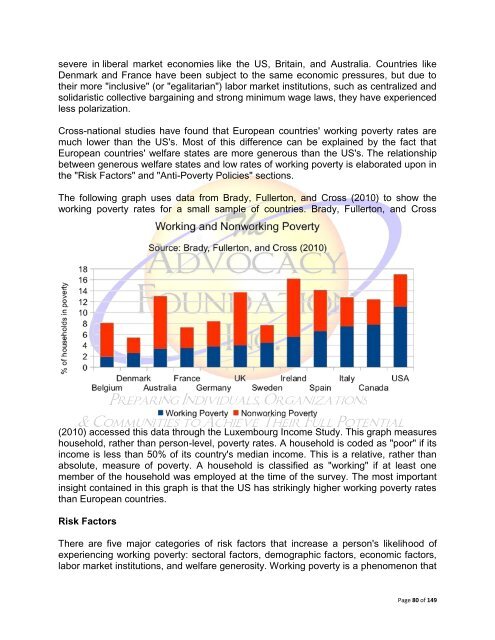Hidden Unemployment
Hidden Unemployment
Hidden Unemployment
You also want an ePaper? Increase the reach of your titles
YUMPU automatically turns print PDFs into web optimized ePapers that Google loves.
severe in liberal market economies like the US, Britain, and Australia. Countries like<br />
Denmark and France have been subject to the same economic pressures, but due to<br />
their more "inclusive" (or "egalitarian") labor market institutions, such as centralized and<br />
solidaristic collective bargaining and strong minimum wage laws, they have experienced<br />
less polarization.<br />
Cross-national studies have found that European countries' working poverty rates are<br />
much lower than the US's. Most of this difference can be explained by the fact that<br />
European countries' welfare states are more generous than the US's. The relationship<br />
between generous welfare states and low rates of working poverty is elaborated upon in<br />
the "Risk Factors" and "Anti-Poverty Policies" sections.<br />
The following graph uses data from Brady, Fullerton, and Cross (2010) to show the<br />
working poverty rates for a small sample of countries. Brady, Fullerton, and Cross<br />
(2010) accessed this data through the Luxembourg Income Study. This graph measures<br />
household, rather than person-level, poverty rates. A household is coded as "poor" if its<br />
income is less than 50% of its country's median income. This is a relative, rather than<br />
absolute, measure of poverty. A household is classified as "working" if at least one<br />
member of the household was employed at the time of the survey. The most important<br />
insight contained in this graph is that the US has strikingly higher working poverty rates<br />
than European countries.<br />
Risk Factors<br />
There are five major categories of risk factors that increase a person's likelihood of<br />
experiencing working poverty: sectoral factors, demographic factors, economic factors,<br />
labor market institutions, and welfare generosity. Working poverty is a phenomenon that<br />
Page 80 of 149

















